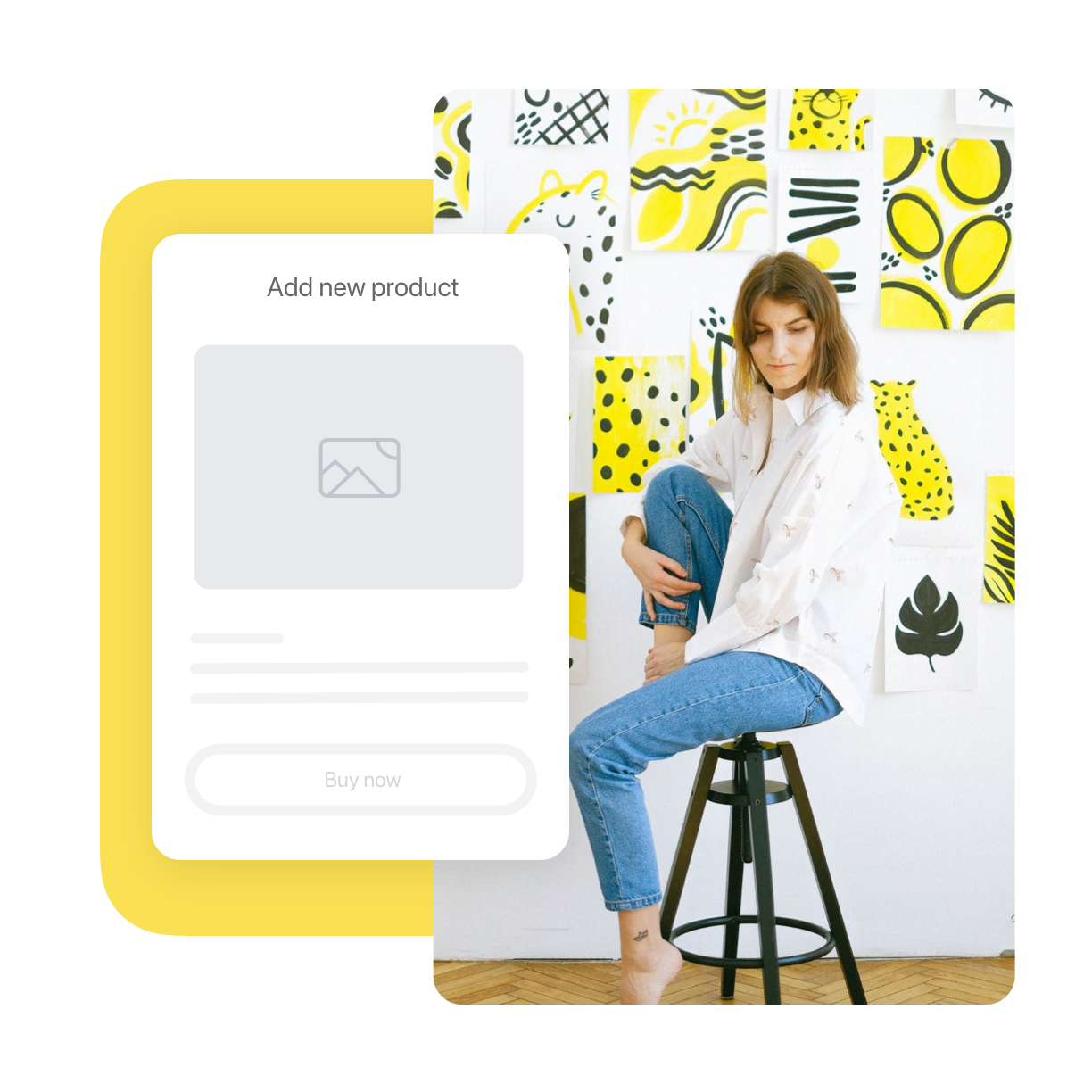Ecommerce for art sellers
How To Sell Art Online And Make Money With Ecwid

With 92% of millennials purchasing art online, there’s no point in waiting another day to get started.
Stay true to yourself — and create!
It’s not rocket science. Creating an online store takes 5 minutes!
Why Ecwid?

Sell Arts On the Go

The Best Way to Sell Arts Online

Your Guide to Selling Arts Online for Beginners
Let’s learn how to sell art online.

“Stay focused and don’t be distracted by anyone saying you can’t or shouldn’t follow your dreams of being an artist. Take any and every opportunity (within reason) to showcase your work. It takes time, but if you’re diligent… it will pay off in the long run.”
Skye Walker, a street artist from Encinitas, CA, once said this in an interview about his life as an artist. He, as well as thousands of artists around the world, know something about dedication. They resist the world’s pragmatism and the impulse to live a normal life, find a stable job, and to work towards maximum efficiency. Nowadays, artists find themselves in a difficult balancing act between creating work they care about and making a living.
Yes, the world knows many successful artists who don’t have to pinch pennies, but many more creators are looking for recognition, and struggling to pay their rent along the way.
Maybe this proves that though things have changed since the times of Washington, there is still a way to beautifully showcase your creations, reach out to the world, build up an audience, make money doing what you love, and, most importantly, become a
Dream chasers and creators of any kind, we invite you to enter a world with no boundaries, where everyone is one click away no matter their physical distance, to a place where everything is possible.
Overview
Art market: offline down, online up
With $64.1 billion in sales in 2019, the art market dropped by 5 percent compared to 2018, as “The Art Market 2020” report by Art Basel and UBS indicates. However, if we split selling offline in the galleries and online using platforms and websites, the picture looks a lot brighter for
According to Statista estimates, the global online art market value in 2019 was $4.8 billion, which is 7.5 percent of the market. And online art sales are forecast to increase to a total of $9.32 billion by 2024.
But the market is a habitat for two creatures: the seller and the buyer. Selling art online has been driven by a new generation of customers: millennials. According to the report, millennials now make up nearly half (49 percent) of all collectors globally. And 92 percent of them buy art and collectibles online.
Due to coronavirus, and the subsequent cancellation of significant offline art events in 2020, the online art market’s future looks bright and promising. Like in any other niche, the art selling experts say that lockdown presents a great opportunity to start selling online.

How do I sell my artwork online?
Art has always been hard to sell, even though it’s an essential contributor to our everyday lives and culture. The complexity lies in the variety: each artist is different, their mood is never the same and this translates to their work. The same is true with buyers, who also flow from one mental state to another. A particular piece of art might not match a specific buyer’s mood. But when the buyer’s and the seller’s tastes align, purchasing magic happens.
So is there a way for artists to influence this alchemy?
Yep! Actually, two of them. If you want to sell your artwork, you can:
- follow trends in your field and create what’s in demand or;
- scale your reach and raise the chances of finding a buyer who likes the same things you do.
Is selling art online profitable?
That is the central question. Inspiration, education, and beauty itself won’t pay your bills. If you want to dedicate 100% of your life’s work to art, it has to feed you.
So, how much can you earn by selling art?
The answer is: as much as the effort you put into it. If you sell only physical art, then you’re missing a fantastic opportunity offered by the digital world — selling digital products (digital arts or digital copies). If you turn your art into digital products, selling art online might be difficult at first. But in a little while, you will find yourself able to sell the same pieces that you created years ago, without running out of stock. And that’s the beauty of selling art online.
From $10 to $50,000 per piece — the sky’s the limit as far as price is concerned. Well, taking into consideration how much your customers are willing to spend, of course.
What art can I sell online to make money?
If you’re an artist and want to sell your pieces online, you’ll have to think about how best to repurpose your art. There’re so many ways you can create different products based on a single piece of work.
Use different surfaces:
- Wood
- Metal
- Glass
Think of decor:
- In frame
Glass-covered - Poster
Digitalize:
- Downloadable images
- Desktop wallpapers
- Digital calendars
Print it on things:
- iPhone cases
- Pillows
T-shirts
What types of visual art are in demand?
Imagination knows no boundaries. However, it’s a good idea to understand market preferences, and offer something that will attract potential buyers. Good demand requires great supply, as they say.
Here are the
- Abstract art
- Impressionism
- Pop art
- Cubism
- Modern art
If we’re talking about the themes or topics of the art pieces, Art Business News magazine has spotlighted the following:
- Traditional landscapes
- Local views
- Modern or
semi-abstract landscapes - Abstracts
- Dogs
What size paintings sell best?

How to know if my art is good enough to sell?
Why do you think it isn’t? Just do your best when, follow your artistic impulses, and work hard to get your piece to the market so people will see it!
Of course, fame and glory don’t come in a day. But if you keep doing what you like, exploring trends in your field to get inspired, you might just work up to shocking the market with your talent.
Still feeling a little apprehensive about your artistic “worth”? Well, if you submit your work to an offline or online (recommended!) gallery, they will provide an assessment (usually for free). This way, you will know exactly how much your painting is worth. You never know, it might be worth more than you think.
How do I copyright my artwork?
This topic could fill its own guide. But to make a long story short, tangible pieces of art are already copyrighted. Unfortunately, their digital copies are not, unless they have any identification sign (like a watermark) that proves that it’s a copy of your original artwork.
It means if you didn’t sign your painting and someone took a picture of it
Another great way to protect your property is to register it! In the US, you can copyright artwork by submitting individual pieces to the Library of Congress Copyright Office. It will create a proof of ownership and entitle you to ask for more money if you need to sue someone for copyright infringement.

Practice
How do I get started selling art?
Getting started isn’t easy. There is a long checklist of things to consider. And it will depend on the type of art you create and the materials you use. However, we’ve taken the liberty of outlining some major things to think about to get the ball rolling.
Professional photography. Submitting your art to online galleries or selling them online will require
Packaging and delivery. If you assume that any delivery service will take good care of your painting, you could be wrong. Do some planning in terms of packaging to make sure your art pieces are safe on their journey to the buyer.
Uploading to market. It will take time to organize your inventory in online galleries or art marketplaces. Budget that time into your planning now, rather than later.
Starting a website. Your art needs a (virtual) home where your fans can find you, connect with you, and, most importantly, buy from you. Try one without commissions. We have some suggestions, below.
What is the best place to sell art online?
You know the phrase: more is more. Try to introduce yourself to as many people as possible through the internet. Expand to all possible channels that your potential customer might visit.
Some ideas:
- The big three: Amazon, eBay, Etsy. Each has a dedicated section for artists.
- FineArtAmerica. One of the largest art marketplaces in the world.
- Saatchi Art. a marketplace with 1.7 million monthly visitors.
- Society6. An awesome place to print your art on things and sell them.
- Art(dot)com. If you can’t find your category here, you won't find it anywhere.
- Artsy. A massive online gallery for artists from all over the world.
Sell art through your website
A website is a
Paintings, prints, merchandise — with a website, everything you have to offer can be seen and explored on one storefront without other vendors getting in the way. It’s just a more friendly and authentic customer experience to have customers shop directly from you, instead of working through a third party interface.
Plus, you have control over the entire website. Colors, typography, layout, galleries, combinations, collections — you can organize everything the way you like it.
You can use your website/online store to sell arts and crafts, and connect your inventory to multiple sales channels: social media, marketplaces, POS, etc.
Selling art online
A perfect website for selling art
Your website or online store should reflect your individuality as an artist. A perfect online store to sell art should have:
- Actual inventory. If you don’t have anything — it’s time to make something!
- Large images with a
zoom-in feature. - A clean design to keep customers focused on the art.
- Collections to gather different products with common looks or themes.
- Extensive descriptions to tell the story behind each piece.
- Secure checkout to build trust with your customers.
- Comprehensive legal docs (especially on your shipping policy).
- A page with a story about the artist to build an emotional connection with your customers.
Marketing for selling arts and crafts online
No magic. Only classic techniques.
Motivation
Cross-selling - First purchase discount
Time-limited offer
Journey management
- Category “New”
- Category “Bestseller”
- Category “On Sale”
Retention
- Abandoned cart emails
- Newsletter subscription
- Like this product
Word of mouth
- Affiliate program
- Share on social media
- Buy as a present
How do I deliver my arts?
If you sell digital copies of your art, you can skip this question. Your
But if you sell physical pieces, make sure to take care of the following:
- Use wooden crates to ship large unframed pieces or
mid-sized framed ones (18"x24"). - Cover the art with protective material like cardboard, bubble wrap, or cloth to avoid damage.
- If you ship several flat pieces in a tube, put glassine paper between them and make sure they’re facing the same direction.
- If you’re shipping paintings with glass, tape several strips of painter’s tape on each in an
X-shape and wrap the pieces with a cling film. - Use cardboard corner protectors to secure your artwork’s edges.
- Wrap up each of the art pieces you ship with two layers of bubble wrap — whether it’s a single work or several in one crate.
- Don’t leave any empty space in the box (or tube, or crate) — fill it completely with bubble wrap, paper, or packing peanuts.
- Seal your container with
heavy-duty, high-quality packaging tape.
The Ecwid experience
Selling art online with Ecwid
If you’re an artist thinking about selling online, you’ve come to the right place. With Ecwid, you can start your own online store to show your artwork to millions of people, all while providing customers with a convenient and fast way to buy your work. Whether you are an artist, a designer, aSell simultaneously
An Ecwid store looks perfect on any device — whether it be a phone, laptop, tablet, smart TV, or smartwatch.
Add an online store to Facebook, Instagram, Tumblr, or any other social media site.
Sell globally with
8 Steps to start selling arts online with Ecwid
An Easy Ecommerce Shopping Cart
to Sell Arts Online
Ecwid’s ecommerce platform offers you the resources to help you grow your talent or skill into a profitable and efficient business.
No coding
By removing the headaches of manually setting up your own personal website and outfitting it with shopping cart functionality, Ecwid provides automation and an
Secure payments
Furthermore, Ecwid’s proficiency and outreach in ecommerce ensures that you will be provided a secure system for your business transactions, as well as a vibrant marketplace for reaching a large customer base.
Online and offline
With an extensive background in online technology, Ecwid is able to cater not only to businesses already selling arts online, but can also provide an
Marketplaces
Ecwid does not depend on one model of outreach to sell arts online, but many. It makes use of a comprehensive and efficient interface, along with high functionality that enables you to sell on every major ecommerce platform at once — Google Shopping, Amazon, eBay.
Social selling
Talking about selling arts on social media, Ecwid will help you distribute your products across major social networks like Facebook, Instagram, TikTok, Pinterest, Snapchat, etc. Everything from one control panel.
With Ecwid running under the hood of your shop, you’ll have a beautiful store that grants you global reach for selling your arts everywhere.
Start Selling Arts Online Today
Set up your Ecwid store once to easily sync and sell across a website, social media, marketplaces like Amazon, and live

